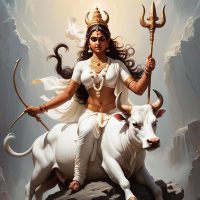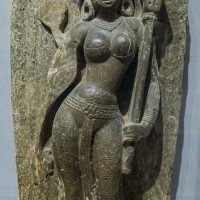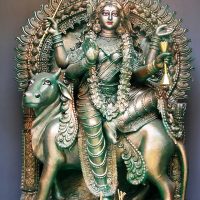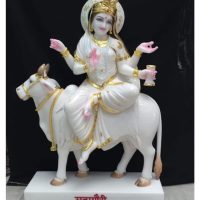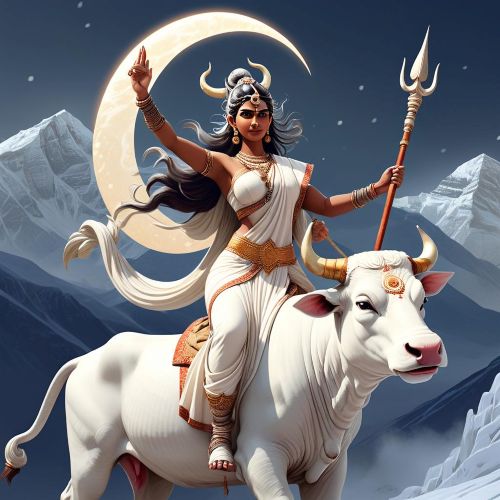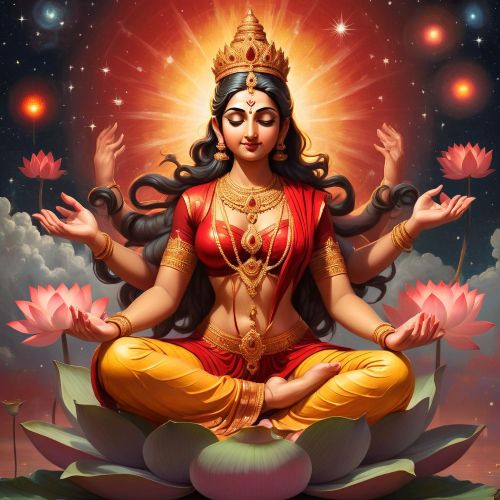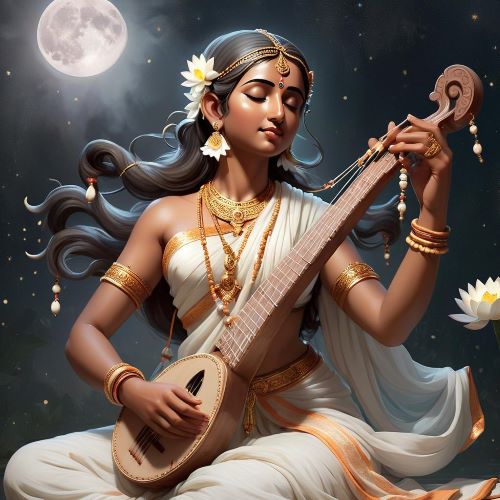Mahagauri : Goddess of Purity
Listen
At a glance
| Description | |
|---|---|
| Origin | Indian Mythology |
| Classification | Gods |
| Family Members | Shiva (Husband), Ganesh, Karthikeya (Children) |
| Region | India |
| Associated With | Purity, Penance |
Mahagauri
Introduction
Mahagauri, the eighth form of the Navadurga, is revered in Hindu mythology as the goddess of purity, serenity, and transformation. The name “Mahagauri” translates to “the great fair one” or “extremely white,” reflecting her radiant beauty and spiritual brilliance. She represents the final stage of penance and austerity undertaken by Goddess Parvati in her quest to unite with Lord Shiva. Worshipped on the eighth day of Navaratri, known as Ashtami, Mahagauri embodies the triumph of inner light over darkness. Her story highlights the themes of renewal, forgiveness, and the transcendence of suffering through devotion and discipline.
Physical Traits
Mahagauri is portrayed with a dazzlingly fair complexion, often compared to jasmine, the conch, or the moonlight. She is traditionally shown riding a white bull, called Vrishabha, which represents righteousness and steadfast devotion. Her attire is entirely white, reinforcing her connection with peace, purity, and simplicity. In iconography, Mahagauri has four arms. She carries a trident in one hand, symbolizing divine power, and a damaru (drum) in another, reflecting rhythm, creation, and her link to Shiva. The other two hands are depicted in abhayamudra, granting protection, and varadamudra, bestowing blessings. This youthful goddess radiates calmness and tranquility, embodying both divine beauty and maternal compassion.
Family
Mahagauri is identified with Goddess Parvati, consort of Lord Shiva, and shares her life and legends. She is mother to Lord Ganesha, revered as the remover of obstacles, and Kartikeya, the god of war. Her origin story is deeply tied to her relationship with Shiva. Ancient texts describe how Parvati performed intense penance to win Shiva’s affection, causing her body to darken with dust and hardship. When Shiva bathed her in the holy waters of the Ganga, her brilliant fair form was revealed as Mahagauri. This transformation symbolized not only her devotion but also the cleansing of all impurities. In some traditions, her identity is linked to the form that arose to defeat the demons Shumbha and Nishumbha, highlighting her role as both nurturer and protector.
Other names
Mahagauri is worshipped under several names that reflect her qualities and symbolism. She is often called Gauri, a term widely associated with Parvati and meaning “the fair one.” Another title, Shwetambardhara, describes her as the goddess clad in white garments. As Vrisharudha, she is remembered as the goddess who rides the bull, signifying dharma and strength. In different scriptures, she is also referred to as Ambika, a nurturing mother figure, and Mahadevi, the great goddess who encompasses all aspects of feminine divinity. In certain traditions, she is equated with Mahasaraswati, representing wisdom and purity after the fierce battles of Durga. Each of these names captures a unique aspect of her divine essence and role in mythology.
Powers and Abilities
Mahagauri’s powers are associated with purification, inner transformation, and divine grace. Her most celebrated ability is the removal of past sins and negativity, offering devotees the chance for renewal and spiritual growth. Her trident embodies her power to destroy evil and safeguard her devotees, while her damaru symbolizes cosmic vibration and the continuity of creation. Through her abhayamudra, she instills fearlessness, and her varadamudra assures the granting of wishes and prosperity. Mahagauri is also believed to alleviate the malefic effects of the planet Rahu in astrology, bringing peace and clarity of mind. Her presence is linked with the Sahasrara Chakra, the crown center of energy, guiding seekers toward enlightenment and union with the divine. Though serene in form, she retains the latent force of Durga, able to vanquish even the fiercest of demons when needed. Worship of Mahagauri is said to bring harmony, wealth, and liberation, as well as peace in familial and marital relationships.
Modern Day Influence
In contemporary practice, Mahagauri holds a central place in Navaratri celebrations. On Ashtami, devotees honor her by wearing white, offering coconuts, milk, and white flowers, and reciting mantras dedicated to her. One of the most important rituals of the day is Kanya Puja, where young unmarried girls are worshipped as living embodiments of the goddess, symbolizing divine innocence and feminine energy. Beyond festivals, Mahagauri’s story of transformation serves as an inspiration for those seeking spiritual growth, resilience, and new beginnings. She is invoked by devotees hoping for peace in their households, blessings in marriage, and guidance on the path of self-realization.
Her influence extends into art, literature, and digital media, where depictions of Mahagauri often emphasize her serene face and luminous presence. In modern spiritual discourse, she is seen as a symbol of renewal and empowerment, resonating with people searching for release from past struggles and the courage to embrace transformation. Practices in yoga and meditation also draw on her symbolism, particularly in teachings that focus on purification of the mind and elevation of consciousness. For many, Mahagauri represents the possibility of moving beyond hardship into a life filled with clarity, grace, and inner freedom.
Related Images
Source
Awaz the Voice. (2025, September 27). Navratri Day 8: Goddess Mahagauri symbolises serenity, purity and victory. https://www.awazthevoice.in/heritage-news/navratri-day-goddess-mahagauri-symbolises-serenity-purity-and-victory-42015.html
Indian Mythology. (2024, September 18). What is the story behind goddess Mahagauri? Serene Form. https://indianmythology.co.in/what-is-the-story-behind-goddess-mahagauri/
Wikipedia. (2013, February 3). Mahagauri. https://en.wikipedia.org/wiki/Mahagauri
Tell-a-Tale. (2017, September 20). Story of Eighth Day of Navaratri – Goddess Mahagauri. https://www.tell-a-tale.com/mahagauri-the-goddess-worshipped-on-the-eighth-day-of-navratri/
Rudraksha Ratna. (2025, August 18). Mahagauri Devi (Navratri Day 8 Goddess). https://www.rudraksha-ratna.com/articles/mahagauri-devi
Sanskriti Magazine. (2024, April 14). Day 8: Goddess Mahagauri – The Beacon of Purity and Serenity. https://www.sanskritimagazine.com/navratri-series-day-8-goddess-mahagauri-the-beacon-of-purity-and-serenity/
Pilgrimage Tour. (2024, October 9). Maa Mahagauri: Eighth Form of Maa Durga. https://www.pilgrimagetour.in/blog/maa-mahagauri/
Drik Panchang. Goddess Mahagauri | Devi Mahagauri | Maa Mahagauri. https://www.drikpanchang.com/hindu-goddesses/parvati/durga/navdurga-mahagauri.html
Kinsley, D. R. (1988). Hindu Goddesses: Visions of the Divine Feminine in the Hindu Religious Tradition. University of California Press.
Pattanaik, D. (2010). Devi: The Mother-Goddess – Her Forms and Functions. Inner Traditions.
Foulston, L., & Abbott, S. (2009). Hindu Goddesses: Beliefs and Practices. Sussex Academic Press.
Brown, C. M. (1998). The Triumph of the Goddess: The Canonical Models and Theological Visions of the Devi-Bhagavata Purana. SUNY Press.
Coburn, T. B. (1991). Encountering the Goddess: A Translation of the Devi-Mahatmya and a Study of Its Interpretation. SUNY Press.
Frequently Asked Questions
What is lorem Ipsum?
I am text block. Click edit button to change this text. Lorem ipsum dolor sit amet, consectetur adipiscing elit. Ut elit tellus, luctus nec ullamcorper mattis, pulvinar dapibus leo.
What is lorem Ipsum?
I am text block. Click edit button to change this text. Lorem ipsum dolor sit amet, consectetur adipiscing elit. Ut elit tellus, luctus nec ullamcorper mattis, pulvinar dapibus leo.
What is lorem Ipsum?
I am text block. Click edit button to change this text. Lorem ipsum dolor sit amet, consectetur adipiscing elit. Ut elit tellus, luctus nec ullamcorper mattis, pulvinar dapibus leo.
What is lorem Ipsum?
I am text block. Click edit button to change this text. Lorem ipsum dolor sit amet, consectetur adipiscing elit. Ut elit tellus, luctus nec ullamcorper mattis, pulvinar dapibus leo.
What is lorem Ipsum?
I am text block. Click edit button to change this text. Lorem ipsum dolor sit amet, consectetur adipiscing elit. Ut elit tellus, luctus nec ullamcorper mattis, pulvinar dapibus leo.


